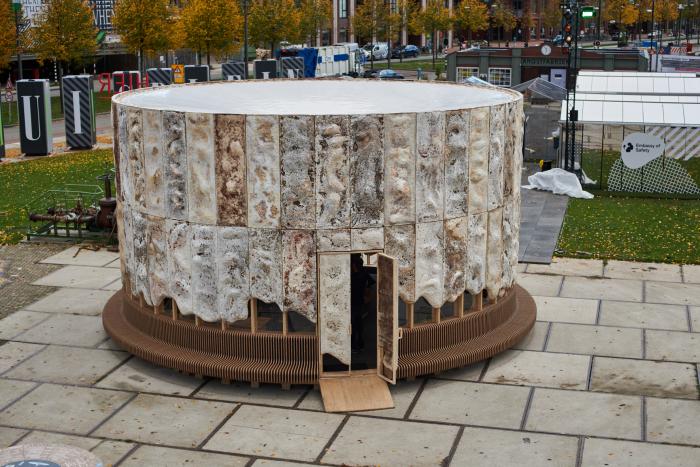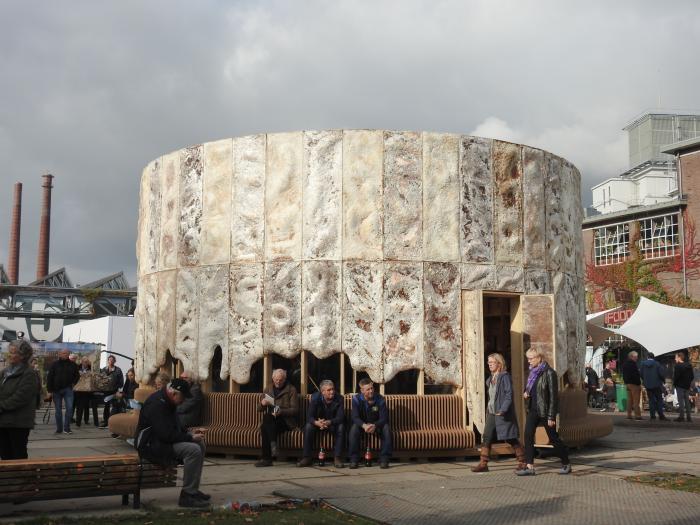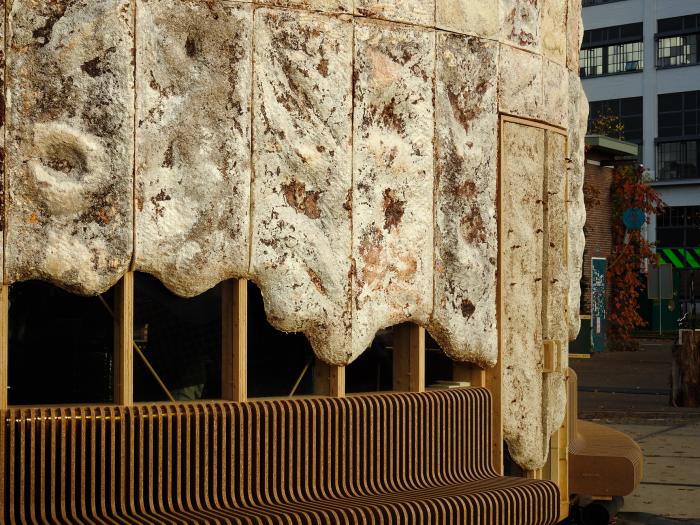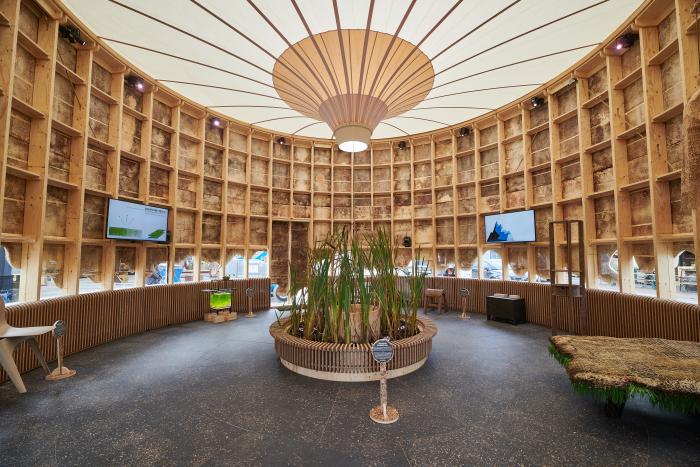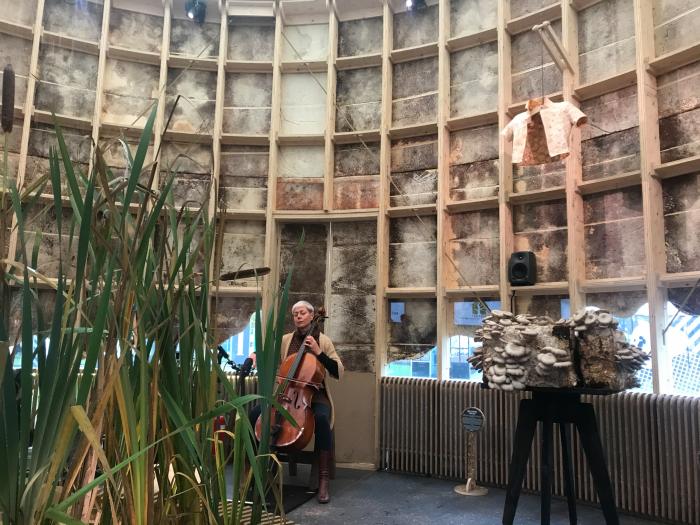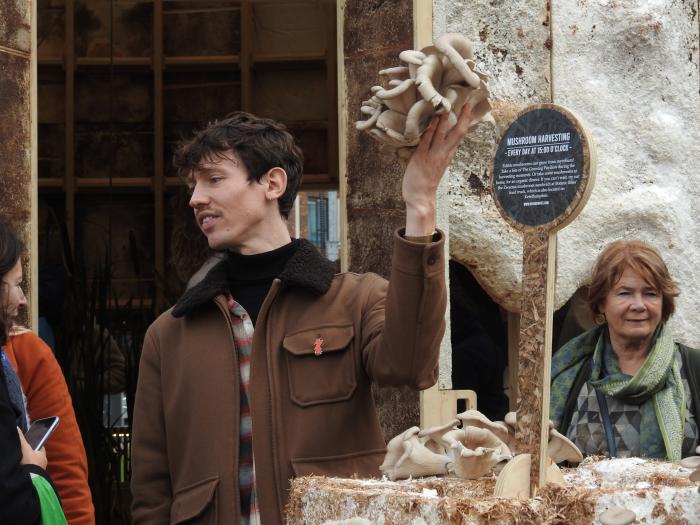I. SUMMARY INFORMATION
Project
268448
Status
Submitted
Award category
Techniques, materials and processes for construction and design
You want to submit
NEW EUROPEAN BAUHAUS AWARDS : existing completed examples
Project title
The Growing Pavilion
Full project title
The Growing Pavilion
Description
The Growing Pavilion is an ode to the beauty and power of biobased materials. It stands as a necessary and viable solution for reducing the rising impacts of climate change and the use of fossil resources. With this structure we show the possibilities, and above all the wonderful beauty, of biobased construction. The pavilion is unique in the way in which a large number of biobased materials, such as wood, hemp, mycelium, cattail and cotton, come together to form an extraordinary creation.
Where was your project implemented in the EU?
Netherlands
North Brabant
Ketelhuisplein
51.44827798723953
5.457443905851704
Eindhoven
5617 AE
When was your project implemented?
Has your project benefited from EU programmes or funds?
No
Which programme(s) or fund(s)? Provide the name of the programme(s)/fund(s), the strand/action line as relevant and the year.
II. DESCRIPTION OF THE PROJECT
Please provide a summary of your project
The Growing Pavilion is an ode to biobased materials. It stands as a necessary and viable solution for reducing the rising impacts of climate change and the use of fossil resources. We show the possibilities and the new aesthetic of biobased materials to trigger a turnaround in thinking and acting. By combining research and art, we brought our vision to life.
The pavilion is made up of five grown core raw materials: wood, residual flows from the agricultural sector, mycelium, cattail and cotton. With every material we use, we show the natural raw material as much as possible. We use them in a way to emphasize their own, distinctive identity. In this way, the pavilion acquires a unique, organic texture, color and experience. Besides showing the beauty and strength in the construction of the pavilion itself, we fill the interior of the pavilion with grown design objects to show how beautiful biobased furniture, lamps, cabinets and other objects are.
The Growing Pavilion was built on many years of research. We have documented and showcased our research process in different ways, aiming for full transparency. F.E. in the “Materials Atlas”, we share the collection of all materials found and used. Through this, we wanted to show how far we could go, with the ambition to reach fully biobased creations. But also what the near future would bring. However, it takes more than good materials to make large-scale applications possible. Think of sufficient raw materials, appropriate regulations, innovative designers and open minded consumers. With The Growing Pavilion we also put this conversation on the agenda and facilitate this conversation, because this is essential to achieve the desired change in thinking and doing.
The Growing Pavilion could be visited in the beating heart of Dutch Design Week 2019. More than 75,000 people -professionals and daily visitors- visited the pavilion there already. Soon The Growing Pavilion can be visited again during Floriade 2022 in Almere.
Please give information about the key objectives of your project in terms of sustainability and how these have been met
The need for a Biobased Economy becomes increasingly stronger. The use of biological or grown, instead of fossil, materials is an important solution for reducing plastic (waste), preventing subsidence, capturing CO2 and reusing waste from agriculture. “At this moment 95% of the world's energy comes from fossil fuels which caused the output of CO2 to increase immensely over the last 100 years and to be exhausted soon. Per day the world population uses as much petroleum as the world can ‘produce’ in 1000 years. We have to find an alternative or society will see a fast and huge fall back,” so explains CoEBBE (2019). The building sector can also not be left behind. Governments and consumers set stricter requirements for building materials and governments increasingly make sure that the polluter pays. This makes many conventional building materials more expensive, which is both a necessity and an opportunity for biobased building materials.
The facade of The Growing Pavilion is made of mycelium. Mycelium is a mixture of the spawn of the Reishi mushroom and plant remains. In the Netherlands, these are mainly remnants of locally growing crops such as hemp, cattail and mace. During the production of one ton of mycelium, two tons of CO2 are captured from the atmosphere. The pavilion also consists of grown core raw materials such as cattail, wood, residual flows from agriculture and cotton. The use of biobased materials has resulted in a saving of 24 tons of CO2, which is what an average Dutch person emits in about 2.5 years. In addition, the pavilion is 95% circular. In other words, 95% of the pavilion can be reused or returned to nature.
An essential part of our vision is to map and share the growth opportunities of the different materials. We have brought all this information together in the Material Atlas. The passport of the pavilion. In this way we want to make as many parties as possible aware of the problem, so that solutions and innovations can be realized faster.
Please give information about the key objectives of your project in terms of aesthetics and quality of experience beyond functionality and how these have been met
The Growing Pavilion is an ode to the beauty and power of biobased materials. Too often biobased materials are offered as a sustainable alternative for conventional materials. Producers tell the biobased materials are just as good or not to be distinguished from the conventional materials. We think this is weak: biobased materials are often smarter, more original, prettier, healthier and more ingenious than the materials we already know.
Therefore for every material we use in The Growing Pavilion, we show the natural element the material is made of as much as possible. In this way the pavilion gets a unique, organic texture, color and experience. The outside walls of the pavilion, for example, are not made into smooth white walls, although this could have been done easily. We have explicitly allowed the mycelium to mature longer so that an organic texture and color is created. The stains and relief of the mycelium are beautiful, it forms a kind of skin instead of an even wall.” We promote this power as a new aesthetic that gives biobased materials their own beautiful identity. In addition to showing the beauty and power in the construction of the pavilion itself, we fill the interior of the pavilion with grown design objects. They show visitors of the pavilion how beautiful grown furniture, lamps, cupboards and other objects are.
The crops we needed to make these materials were placed in the center of the pavilion. We show how we literally bring nature back into our living environment and what soothing impact it has on the human state of mind. There is no more powerful way to demonstrate this by letting the rainwater flow into the center of the pavilion, thus watering the plants that are literally and figuratively central to the pavilion and from which all the materials originated. The rhythm of the dripping water brings us back in contact with nature. By continuously relating ourselves to nature, we also deal with her in a more intense and respectful way.
Please give information about the key objectives of your project in terms of inclusion and how these have been met
The pavilion's aesthetics appeal to a lot of people. The material makes people curious and draws people in. In combination with the program and through storytelling, we reached a wide audience. In ten days Dutch Design Week more than 75,000 people – industry professionals, governmental figures, organizations but also many “consumers” and design enthusiasts visited the pavilion. The storytellers of Company New Heroes were there every day to bring the pavilion further to life. People could inform themselves via information boards, videos and a materials atlas and / or hear more in one of the tours. Jacqueline Hamelink created Growing Music especially for Dutch Design Week. Every morning there was a live concert in the pavilion with music by J.S. Bach. Nature sounds and improvisations were added to this and a soundscape was built that was played during the day in the pavilion. We organized daily harvesting of edible oyster mushrooms that grew from mycelium, so visitors could harvest and taste fungi. In addition to showing the beauty in the construction, visitors could view other biobased creations made by different designers in the pavilion. They show how beautifully grown furniture, lamps and other objects are.
Please give information on the results/impacts achieved by your project in relation to the category you apply for
The Growing Pavilion pushes innovation in sustainability. We challenged material producers and designers to further develop their material to make it applicable in the pavilion and therefore the building industry. The Growing Pavilion is unique in the way in which a large number of biobased materials come together on a large scale, in that way it creates real impact. Residual flows from the agricultural sector are upcycled into building materials instead of fermented, in this way the pavilion contributes to a circular economy.It shows that biobased building is already possible. And it shows what the near future will bring.
Materials are shown in such a way that they emphasize their beauty and strength as much as possible. People became curious about the special design and unknown use of materials. They asked questions and were drawn in, where we could tell them more about the materials, but also about the usefulness and necessity of biobased construction. By telling our story in many different ways, we have touched a wide audience in the head and in the heart. We introduced them to and made them think about biobased construction and design.
The producers and designers of the materials we use have become more widely known and have a broader network. They have seen interest in their material rise.
Working open source is necessary to reach new heights. We have included all the knowledge we have gained in our search for biobased materials in a Materials Atlas that is still accessible to everyone. With this we also show what is not yet possible. With The Growing Pavilion, we put this conversation on the agenda and facilitate this, because it is essential to achieve the desired change in thinking and actions.
The Growing Pavilion is subject in a large number of scientific, design, interior magazines. We were part of the exposition for Deisgn Capital Lille 2020. And Dezeen gave us a highly recommendation.
Please explain the way citizens benefiting from or affected by the project and civil society have been involved in the project and what has been the impact of this involvement on the project
For the first time in the Netherlands and maybe worldwide biobased materials were poetically brought together in a pavilion that shows the strength, possibilities and beauty of these materials. It shows that biobased materials have a high design quality. Creating a new aesthetic causes a new appreciation for biobased materials, both for designers/ producers/ architects and for the future consumer.
Besides the beauty of biobased materials we also told the visitors of the pavilion and online about the necessity of sustainable building. We made our message accessible and transparent by means of the materials atlas, a short documentary, a ‘how is it made’ video, lectures and more. In this way, a wide audience is touched in the head and in the heart.
A main goal is to work open source. We have included all the knowledge we have gained in our search for biobased materials in a Materials Atlas that is still accessible to everyone. With this we also show what is not yet possible. With The Growing Pavilion, we put this conversation on the agenda and facilitate this, because it is essential to achieve the desired change in thinking and actions.
Please highlight the innovative character of the project
For many materials we’ve used it is the first time that they have been used in this way, such as in the pavilion. In the context of the artistic environment surrounded by the story, the opportunity often arose to experiment together with the producers of the materials, and to communicate transparently. This was new for many producers and designers. Our experience is that many are still insecure and protective. Both in application and in sharing knowledge. The pavilion offers them a "safe" environment in which to experiment and scale up production. We were able to achieve this together with the building parties.
Another important quest that is essential for sustainable construction is to use a material as multifunctional as possible, so that not too many different building materials and techniques are used together. Which ultimately benefits the dismantling and recycling process.
We want the origin of material and technology, in this case mycelium, to be leading in the design. The flexibility with which you can grow mycelium in molds and model yourself has been enlarged in the design. The characteristic relief and the wavy window openings provide a unique dynamic force that makes it seem as if the pavilion is still in full growth. We have let fungus growth and color spectrum run wild. Creating a new aesthetic causes a new appreciation for biobased materials, both for designers/ producers/ architects and for the future consumer.
We show the possibilities and the new aesthetic of biobased materials to trigger a turnaround in thinking and acting. By combining research and art, we brought our vision to life. Because looking at our future, it can only be biobased.
Please explain how the project led to results or learnings which could be transferred to other interested parties
What we especially learned during the research into and the realization of The Growing pavilion is that there is still a lot of unknown about biobased materials. This applies to the builder and architect as well as to the future consumer. More knowledge, understanding and love is needed for these materials. This finding has inspired us to develop The Exploded View Materials & Methods. In which we show a multitude of innovative materials and methods of today, tomorrow and the day after tomorrow. In this way we want to inspire and activate professionals and the public about the possibilities, advantages and beauty of circular and biobased building.
Is an evaluation report or any relevant independent evaluation source available?
No
III. UPLOAD PICTURES
IV. VALIDATION
By ticking this box, you declare that all the information provided in this form is factually correct, that the proposed project has not been proposed for the Awards more than once under the same category and that it has not been subject to any type of investigation, which could lead to a financial correction because of irregularities or fraud.
Yes
